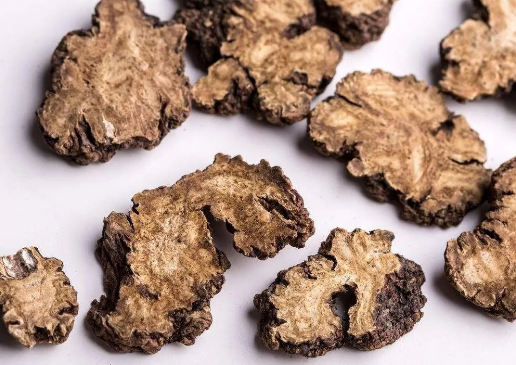Click the top left corner to follow us
Chuanxiong


Plant Source
It is the dried rhizome of the plant Chuanxiong (Ligusticum chuanxiong Hort.) from the Umbelliferae family. Other names include Shan Ju Qiong, Xiong Bo, Xiang Guo, Hu Bo, Ma Xian Xiong Bo. Its effects include invigorating blood circulation and promoting Qi flow, dispelling wind and alleviating pain. Its properties are spicy in flavor, warm in nature; it enters the liver, gallbladder, and pericardium meridians. The characteristics of the herb are that the rhizome is irregularly knotted and fist-shaped, with a diameter of 1.5-7 cm. The surface is yellow-brown to yellow-brown, rough and shriveled, with many parallel raised nodes; the top has a round-shaped depression, and the lower side and nodes have many small tuberous root marks. It is firm and not easily broken, with a cross-section that is yellow-white or gray-yellow, featuring wavy ring patterns, and scattered with yellow-brown oil spots. It has a strong and unique aroma, with a bitter, spicy taste, and a slight sweetness that causes a tingling sensation on the tongue. The best quality is characterized by large, plump pieces, firm texture, yellow-white cross-section, high oil content, and strong aroma. The shapes of the processed slices are: 1. Chuanxiong: irregular thin slices or butterfly-shaped thin slices, refer to the characteristics of the herb. 2. Wine Chuanxiong: deeper color, with a slight wine aroma. 3. Fried Chuanxiong, and bran-fried Chuanxiong: similar in shape to Chuanxiong slices, with a deeper color. Production Areas
1. It is a well-known cultivated medicinal herb, with no wild varieties found.
2. It is mainly cultivated in Jiangsu, Zhejiang, Jiangxi, Hubei, Hunan, Guangxi, Sichuan, Guizhou, Yunnan, Shaanxi, Gansu, and other regions.
3. The main production areas are Sichuan, Guizhou, and Yunnan, with the best quality coming from Sichuan.


Performance Characteristics
1. It is mainly used for chest pain due to blood stasis in the heart meridian, rib pain due to liver Qi stagnation, stabbing pain in the chest and ribs due to liver blood stasis, pain from injuries due to falls, swelling and pain from sores, irregular menstruation, dysmenorrhea, postpartum pain, lochia retention, various types of headaches, and rheumatic pain.
2. Western medicine diagnoses angina pectoris due to blood stasis in the heart meridian, hepatitis due to Qi stagnation and blood stasis, acute and chronic sprains, dysmenorrhea, and vascular headache as blood stasis syndrome.
Clinical Applications
1. For treating chest pain due to blood stasis in the heart meridian, it is often used with Dan Shen (Salvia miltiorrhiza), Gui Zhi (Cinnamon Twig), and Tan Xiang (Sandalwood); for rib pain due to liver Qi stagnation, it is often paired with Chai Hu (Bupleurum), Bai Shao (White Peony), and Xiang Fu (Cyperus); for liver blood stasis, mass accumulation, and stabbing pain in the chest and ribs, it is often used with Tao Ren (Peach Kernel), Hong Hua (Safflower), such as in Xue Fu Zhu Yu Tang (Blood Mansion Eliminating Stasis Decoction) (from “Yi Lin Gai Cuo”). For injuries from falls, swelling, and pain, it can be combined with Ru Xiang (Frankincense), Mo Yao (Myrrh), and San Qi (Notoginseng).
2. For treating blood stasis causing amenorrhea and dysmenorrhea, it is often used with Chi Shao (Red Peony) and Tao Ren, such as in Xue Fu Zhu Yu Tang (Blood Mansion Eliminating Stasis Decoction) (from “Yi Lin Gai Cuo”); if it is due to cold congealing blood stasis, it can be combined with Gui Xin (Cinnamon Heart), Dang Gui (Angelica), such as in Wen Jing Tang (Warming the Menses Decoction) (from “Fu Ren Liang Fang”); for postpartum lochia retention and abdominal pain due to stasis, it can be combined with Dang Gui, Tao Ren, and Pao Jiang (Fried Ginger), such as in Sheng Hua Tang (Generating and Transforming Decoction) (from “Fu Qing Zhu Nu Ke”); for irregular menstruation, early or delayed menstruation, it can be combined with Yi Mu Cao (Motherwort), Dang Gui, such as in Yi Mu Sheng Jin Dan (Motherwort Winning Gold Pill) (from “Yi Xue Xin Wu”).
3. For treating wind-cold headache, it can be combined with Qiang Huo (Notopterygium), Xi Xin (Asarum), and Bai Zhi (Angelica Dahurica), such as in Chuanxiong Cha Tiao San (Chuanxiong Tea-Adjusting Powder) (from “He Ji Ju Fang”); for wind-heat headache, it can be combined with Ju Hua (Chrysanthemum), Shi Gao (Gypsum), and Jiang Can (Silkworm), such as in Chuanxiong San (Chuanxiong Powder) (from “Wei Sheng Bao Jian”); for wind-damp headache, it can be combined with Qiang Huo, Du Huo (Angelica Pubescens), and Fang Feng (Saposhnikovia), such as in Qiang Huo Sheng Shi Tang (Qiang Huo Eliminating Damp Decoction) (from “Nei Wai Shang Bian Huo Lun”); for blood deficiency headache, it can utilize its wind-dispelling and pain-relieving properties, combined with Dang Gui and Bai Shao, such as in Jia Wei Si Wu Tang (Modified Four Substance Decoction) (from “Jin Gui Yi”); for blood stasis headache, it can be combined with Chi Shao and She Xiang (Musk), such as in Tong Qiao Huo Xue Tang (Opening Orifices and Invigorating Blood Decoction) (from “Yi Lin Gai Cuo”).
Related Combinations
1. Chuanxiong combined with Wu Yao (Lindera) has a spicy, warm, and aromatic nature, capable of ascending and descending, reaching the top and the blood sea, serving as a Qi medicine in the blood, effectively invigorating blood; Wu Yao is spicy and opens, warming and unblocking, ascending to the spleen and lungs, descending to the liver and kidneys, with functions of promoting Qi, dispelling cold, and alleviating pain, focusing more on Qi movement. Together, they work to invigorate blood, transform stasis, and promote Qi, suitable for menstrual irregularities, dysmenorrhea, and amenorrhea caused by Qi stagnation and blood stasis.
2. Chuanxiong combined with Dang Gui: Chuanxiong is spicy, warm, and dry, focusing on invigorating blood and promoting Qi; Dang Gui is sweet, nourishing, and slightly dispersing, moistening and oily, focusing on nourishing and harmonizing blood. Together, they achieve the functions of invigorating blood, nourishing blood, and promoting Qi, while balancing dryness and moisture, allowing for the dispelling of stasis without harming Qi and blood, nourishing blood without causing blood stagnation, suitable for blood deficiency and blood stasis headaches, menstrual irregularities, dysmenorrhea, amenorrhea, postpartum abdominal pain from blood stasis, and rheumatic pain.
3. Chuanxiong combined with Bai Shao: Chuanxiong is spicy, warm, and aromatic, invigorating blood and promoting Qi, focusing on ascending and dispersing; Bai Shao is slightly bitter and sour, nourishing blood and astringing Yin, focusing on gathering. Together, they balance invigorating blood and nourishing blood, promoting liver Qi and softening the liver, allowing for the dispelling of stasis without harming Zheng Qi, and promoting liver Qi without damaging liver Yin. Suitable for menstrual irregularities, amenorrhea due to liver blood or liver Yin deficiency, and chest and rib distension and pain due to liver Qi stagnation and blood stasis.
Distinguishing Medicinal Uses
Raw Chuanxiong and Wine Chuanxiong: Raw Chuanxiong has a stronger spicy and aromatic nature, excelling in invigorating blood, promoting Qi, dispelling wind, and alleviating pain, primarily treating various pain syndromes caused by blood stasis and Qi stagnation; Wine Chuanxiong can enhance the upward movement of the medicine and strengthen the blood-invigorating, Qi-promoting, and pain-relieving effects of Chuanxiong, commonly used clinically for headaches due to Qi stagnation and blood stasis, chest and rib pain, amenorrhea, dysmenorrhea, as well as injuries and bone pain.

 Related Discussions
Related Discussions
1. Zhang Jie Gu: It can disperse wind from the liver meridian, a holy medicine for treating Shao Yang, Jue Yin meridian headaches, and blood deficiency headaches.
2. “Ben Cao Yao Lue”: Spicy in flavor and warm in nature, used in blood medicines, it can assist blood circulation; however, if used excessively, it can lead to violent death. It can stop headaches because it has excess; it can disperse insufficiency, guiding clear blood downward. The ancients referred to it as a Qi medicine in the blood, hence it can disperse and guide blood upward. In the case of carbuncles and sores, it is often included because it enters the heart and can disperse. The heart commands Qi and circulates blood; Chuanxiong entering the heart assists the heart in commanding Qi and circulating blood, allowing Qi and blood to flow, thus dispelling evil and resolving swellings.
3. “Ben Cao Gang Mu”: Chuanxiong is a Qi medicine in the blood. The liver suffers from urgency, hence it is supplemented with spiciness, making it suitable for blood deficiency. Spicy disperses, hence it is suitable for Qi stagnation. If blood dysentery has been resolved but pain persists, it indicates Yin deficiency and Qi stagnation; adding Chuanxiong as an assistant can promote Qi and regulate blood, stopping the disease immediately.
4. “Ben Cao Zheng”: Chuanxiong is good at dispersing and also travels through the liver meridian, being a Qi medicine in the blood. Both Chuanxiong and Dang Gui belong to blood medicines, but Chuanxiong’s dispersing action is stronger than Dang Gui’s, hence it can disperse wind and cold, treating headaches. Due to its ascending nature, it can also regulate menorrhagia and dizziness; its sweetness is less, hence dispersing leads to excess, while supplementing leads to insufficiency. For headaches caused by three Yang fire stagnation, it is particularly suitable. Modern people misunderstand the ascending and descending nature, only knowing that Chuanxiong treats headaches, which is a great error.
5. “Ben Cao Hui Yan”: Chuanxiong has a fragrant and dispersing Qi, warm in nature, and its power ascends and descends, reaching everywhere. Its specialty lies in guiding the body’s clear and light Qi to the brain, treating headaches caused by wind attacking the head, headaches caused by floating heat rushing to the head, and headaches due to blood congestion in the brain. Its warming and dispersing power can also unblock Qi and invigorate blood, treating overall stiffness and women’s amenorrhea and infertility.
Related Medicines/Formulas1. Qing Xuan Pian (Tablets), Su Xiao Jiu Xin Wan (Quick-Acting Heart Rescue Pill), Nao An Ke Li (Granules), Xiao Shuan Tong Luo Jiao Nang (Granules, Tablets), Kan Li Sha. 2. Chai Hu Shu Gan San (from “Zheng Zhi Zhun Sheng” citing “Yi Xue Tong Zhi”), Tong Qiao Huo Xue Tang (from “Yi Lin Gai Cuo”), Chuanxiong San (from “Wei Sheng Bao Jian”), Chuanxiong Cha Tiao San (from “He Ji Ju Fang”), Shen Tong Zhu Yu Tang (from “Yi Lin Gai Cuo”).Dosage and Administration
Internal use: Decoction, 3-10g, powdered, 1-1.5g each time, or made into pills or powders.
External use: powdered for sprinkling, or decocted for gargling.
Precautions
1. Chuanxiong is spicy and warm, use with caution for headaches caused by liver Yang hyperactivity.
2. Its warming and drying nature can consume blood and injure Yin; it is not suitable for those with Yin deficiency and excess heat, with red tongue and dry mouth.
3. Women with excessive menstruation and bleeding disorders without stasis should not use it.
4. When administered intravenously, it is advisable to start with a small dose and then gradually increase, otherwise, allergic reactions and other side effects may occur.
Adverse Reactions/Contraindications
1. Excessive or improper use of Chuanxiong can lead to poisoning.
2. Symptoms of poisoning mainly manifest as gastrointestinal symptoms and allergic reactions, such as nausea, vomiting, chest tightness, skin itching, and rashes. In rare cases, women may experience early menstruation and increased menstrual flow.
3. For nausea and vomiting, one can take Huo Xiang Zheng Qi Shui. For allergic reactions such as rashes, one can intramuscularly inject Fenugreek or intravenously inject calcium gluconate, or orally take antihistamines such as Chlorpheniramine or Prednisone; one can also use 10g of Huang Qin, 15g of Sheng Gan Cao, and 30g of mung beans boiled in water for oral administration.
4. Pregnant women should avoid use.

Medicinal Diet Therapy



Huang Qi Chuanxiong Congee: 1. Efficacy: Tonifies Qi, stabilizes pregnancy, invigorates blood, and alleviates pain. Suitable for Qi deficiency with fetal movement, abdominal pain, and bleeding. 2. Ingredients: Huang Qi (Astragalus) 30g, Chuanxiong 5g, Sha Ren (Amomum) 5g, Sang Ji Sheng (Mulberry Mistletoe) 10g, and glutinous rice 10g. 3. Method: Boil Huang Qi, Chuanxiong, Sha Ren, and Sang Ji Sheng to extract the juice, then wash the glutinous rice and cook it with the medicinal juice in a clay pot until it becomes thick porridge. 4. Usage: Consume warm in three portions daily.
Chinese herbal medicine usage varies by individual; please follow medical advice before use.

End




